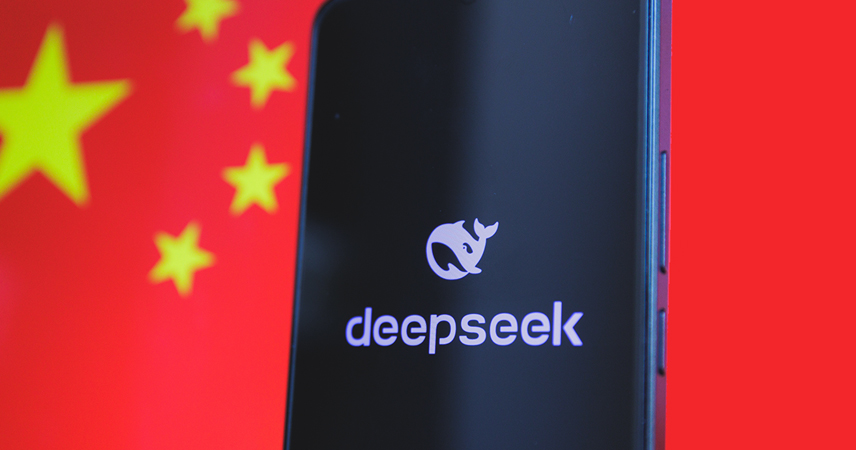The Chinese startup DeepSeek unveiled its new model, DeepSeek-R1, less than a week after the inauguration of U.S. President Donald Trump. This low−cost Chinese innovation, which demonstrates remarkable performance compared with American AI models such as ChatGPT, sent shockwaves through global financial markets. Trained at a cost of no more than $5.6 million, DeepSeek caused a noticeable decline in U.S. stock indices, particularly in the technology sector, on January 27, 2025 when the Nasdaq index lost about 3.1600 billion, before U.S. stocks stabilized the following day.
This rapid development came at a time when American companies are spending billions of dollars on AI model development, amid geopolitical restrictions on exporting advanced electronic chips to China.
While U.S. corporate leaders like Microsoft CEO Satya Nadella insist that China’s advancements must be taken seriously, divisions within Wall Street are growing. Optimists see this temporary downturn as a "golden buying opportunity," while pessimists warn of an AI bubble burst that has inflated the sector’s value to unprecedented levels. Amid this debate, DeepSeek may redefine global competition rules by merging technical efficiency with the ability to circumvent Western sanctions. This raises questions such as whether China’s rising AI sector poses a threat to U.S. supremacy. And what are the implications of this technological battle for global financial stability?
Multiple Implications
The notable decline in U.S. financial markets on January 27, 2025, which coincided with the launch of DeepSeek’s model, reflects deep implications that go beyond financial losses. These can be detailed as follows:
1. Clash of geopolitical and economic interests
The temporary market decline reflects more than just a reaction to Chinese technological progress. It may have been a result of the interaction of two different strategies:
a. China’s strategy
Founded in 2023 with an initial capital of about 10 million yuan (approximately $1.4 million), DeepSeek has demonstrated the ability to develop an AI model at a low cost. Estimates suggest its costs may not exceed 1% of those of similar U.S. models developed by companies like OpenAI and Google. This development questions the assumption that technological superiority is tied to Western companies. While U.S. firms have spent hundreds of billions on AI development through infrastructure and chip improvements, DeepSeek achieved comparable results using 2,000 integrated circuits, bypassing U.S. sanctions aimed at slowing China’s semiconductor progress. Reports indicate that major U.S. companies like OpenAI and Google have invested heavily in these technologies.
Beijing relies on developing innovative solutions in the field of technology despite the sanctions imposed on it, by intensifying cooperation between the public and private sectors. In 2019, China imported an estimated $350 billion worth of chips while producing only 35% of its domestic needs. After sanctions were imposed on Huawei, preventing it from accessing American chips, Beijing launched a massive investment plan worth $143 billion in September 2022 to strengthen its domestic chip industry. These efforts led to Huawei’s launch of the Kirin 9010 processor, built on 7-nanometer technology, in September 2024, bypassing some of the restrictions. This development paved the way for companies like DeepSeek to achieve advancements in artificial intelligence by relying on NVIDIA chips.
Moreover, China spent about $41 billion on chip manufacturing machines in 2024, representing 40% of global spending, with a 450% increase in lithography machine imports in December 2023 to circumvent restrictions imposed by the West. These measures are part of the Made in China 2025 initiative which aims to establish the country as a global tech hub.
DeepSeek also developed the R1 model, which rivals models like OpenAI’s O1, at a staggering 95% lower cost, with exceptional performance in math and programming tests. The Chinese company also launched DeepSeek-V3, a breakthrough model with 671 billion parameters and a “mixture of experts” architecture, enhancing efficiency and reducing costs.
b. U.S. strategy
In this context, President Trump announced the launch of Project Stargate on January 22, 2025—a strategic tripartite partnership in AI infrastructure involving OpenAI, Oracle, and SoftBank, with investments reaching $500 billion by 2029. An initial $100 billion will be invested to build data centers in Texas that are expected to create more than 100,000 jobs in the U.S. Meanwhile, Google invested over $1 billion in Anthropic, a major competitor to ChatGPT.
Washington seeks to hinder China’s technological progress by banning exports of advanced chips and increasing domestic investment in tech infrastructure, particularly in Silicon Valley. In December 2024, new restrictions targeted 140 Chinese companies, including chip equipment manufacturers like NAURA Technology Group, to prevent China from accessing chips for AI and advanced military systems.Beijing has bypassed some of these restrictions through local alternatives and informal channels to obtain banned technology thus challenging U.S. technological dominance. This success revealed the limitations of U.S. tools in achieving their goals, prompting Wall Street to reassess investments in tech-dependent companies. In response, China imposed export bans on critical materials like gallium and germanium, essential for advanced semiconductor manufacturing.
2. AI’s Shift from opportunity to threat
AI technologies, once the main driver of stock market growth, have suddenly become a source of threat. While U.S. companies boasted about attracting investments with promises of a dazzling tech future, DeepSeek serves as a reminder to markets that innovation does not necessarily require massive spending. This has led analysts to question the economic viability of investments like Microsoft’s $80 billion data center project and Stargate.
However, the threats are not only economic; they extend to ethical and security challenges reflected in the flaws of AI models themselves. Models like DeepSeek and ChatGPT often produce inaccurate or deceptive information without warning, which threaten their credibility in sensitive sectors. These systems also exhibit deep biases from their training data—DeepSeek may avoid discussing politically or socially sensitive issues in China, while ChatGPT may reflect Western biases in global event coverage.
From a security perspective, concerns arise about the potential use of these models for complex cyberattacks, especially as critical sectors increasingly rely on AI. In DeepSeek’s case, fears exist that its outputs may be subject to strict censorship aligned with Chinese policies, undermining information autonomy and deepening skepticism about the reliability of Chinese technology in global markets.
These challenges add complexity to the technological competition, where superiority is no longer measured by technical innovation alone but also by the ability to ensure transparency, safety, and neutrality in AI applications.
Critical Repercussions
The rise of DeepSeek’s AI model has several implications, including:
1. Impact on cryptocurrency markets
With Nvidia’s stock falling 6.5%, Microsoft’s 3.5%, and European tech stocks like ASML dropping 9%, the decline in tech stocks triggered a wave of sell-offs in the cryptocurrency market. Nearly $1 billion in digital assets were liquidated, causing Bitcoin to drop 5% and Altcoins to fall by 8-10%. This phenomenon reflects the growing interconnection between traditional and modern financial markets, highlighting the importance of monitoring these changes to understand contemporary investment dynamics.
2. Redistribution of investments
This development may prompt investors to reconsider their strategies, focusing on Chinese AI startups and potentially shifting global capital flows. DeepSeek’s open-source approach reduces technology adoption costs and attracts global developers and startups, contrasting with Silicon Valley’s monopolistic model. China’s success in developing advanced technology despite U.S. chip export restrictions demonstrates the resilience of its model, boosting investor confidence in the ability of Chinese companies to innovate under pressure.
3. Changing industry standards
DeepSeek’s success may lead to new standards in AI model development, emphasizing efficiency and low cost. For example, DeepSeek charges $0.55 per million input tokens, compared to OpenAI’s $15 per million tokens. This significant price difference not only makes advanced AI more accessible but also pressures other companies to rethink their pricing and operational models. Additionally, new standards are expected to focus on flexibility, applicability, and sustainability without requiring major modifications, which would reduce the environmental impact of large-scale models.
4. Decline in tech and energy sectors
Following DeepSeek’s launch of an advanced AI model requiring far less computing power than current U.S. models, stock markets saw notable declines in tech and energy sectors. Shares of tech giants, especially those in cloud computing, fell sharply—Alphabet (Google’s parent company) dropped 3.1%, Amazon 2.5%, and Microsoft 3.55%. These declines reflect investor concerns that DeepSeek’s model may reduce demand for traditional cloud computing services as companies shift to more efficient, cost-effective AI models.
Moreover, energy companies linked to data centers, like Constellation Energy and Vistra Corp, also saw sharp declines. This is attributed to expectations of reduced energy demand at data centers due to DeepSeek’s high efficiency. Other energy sector stocks, like GE Vernova, fell over 21%, reflecting the broad impact of this new technology on the energy market.
Lessons Learned
The decline in U.S. financial markets on January 27, 2025, may signal more than a temporary stock price correction. It could reflect a shift in global technological competition dynamics. DeepSeek’s success in achieving high technological efficiency at low costs despite sanctions raises questions about the assumption of absolute U.S. dominance in innovation. Technological superiority is no longer solely tied to spending but may also depend on the ability to improve efficiency and overcome structural constraints.
These shifts show that financial markets have become highly sensitive to cross-border technological developments, supporting the hypothesis of the interconnection between technology and financial stability. Just as DeepSeek impacted the tech and energy sectors, similar innovations in areas like quantum AI or green computing could disrupt other industries.
Therefore, industrialized nations may need to adopt flexible strategies that balance international cooperation with the protection of vital interests. This shift may require revisiting classical theories of technological dominance, such as the technology life cycle model, which assumes advanced economies control innovation stages. China’s rise suggests emerging economies can reshape this cycle through mechanisms like adaptive innovation, which improves existing technologies rather than inventing them from scratch.


